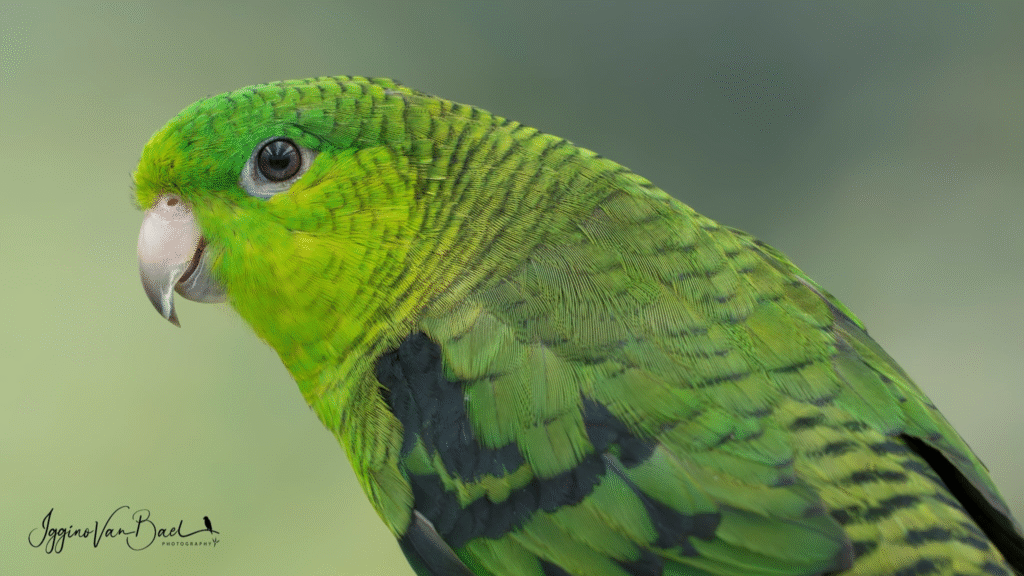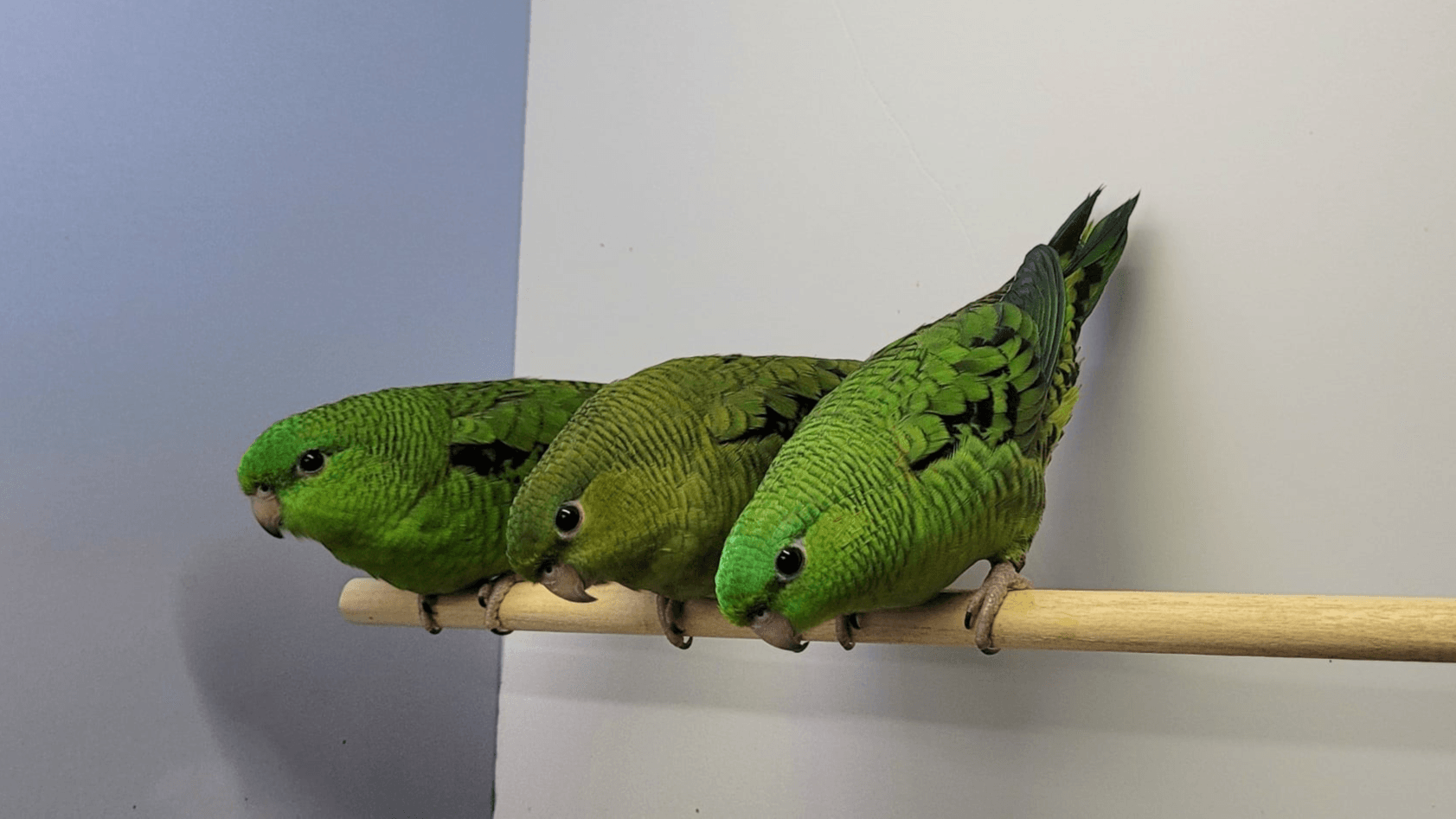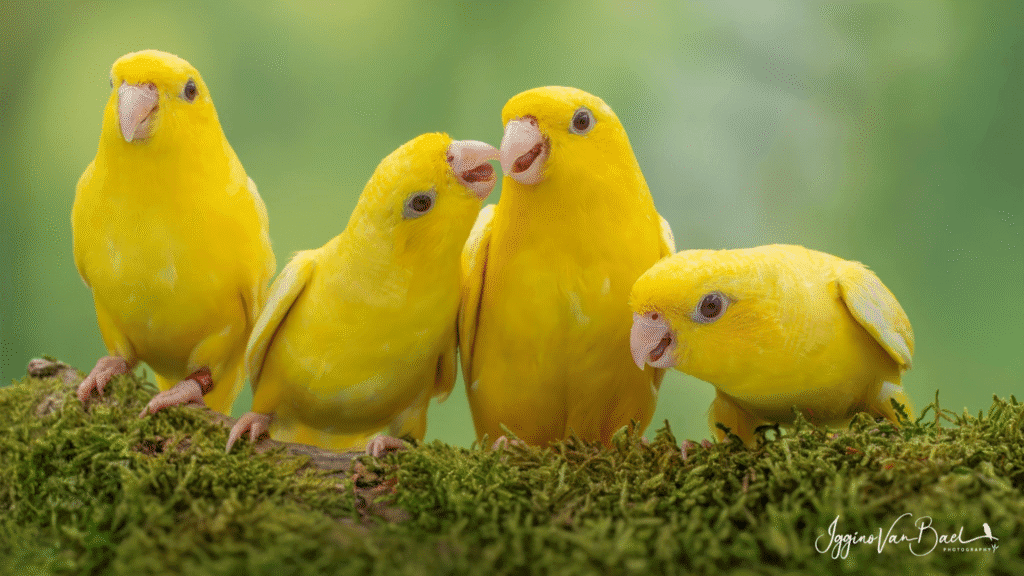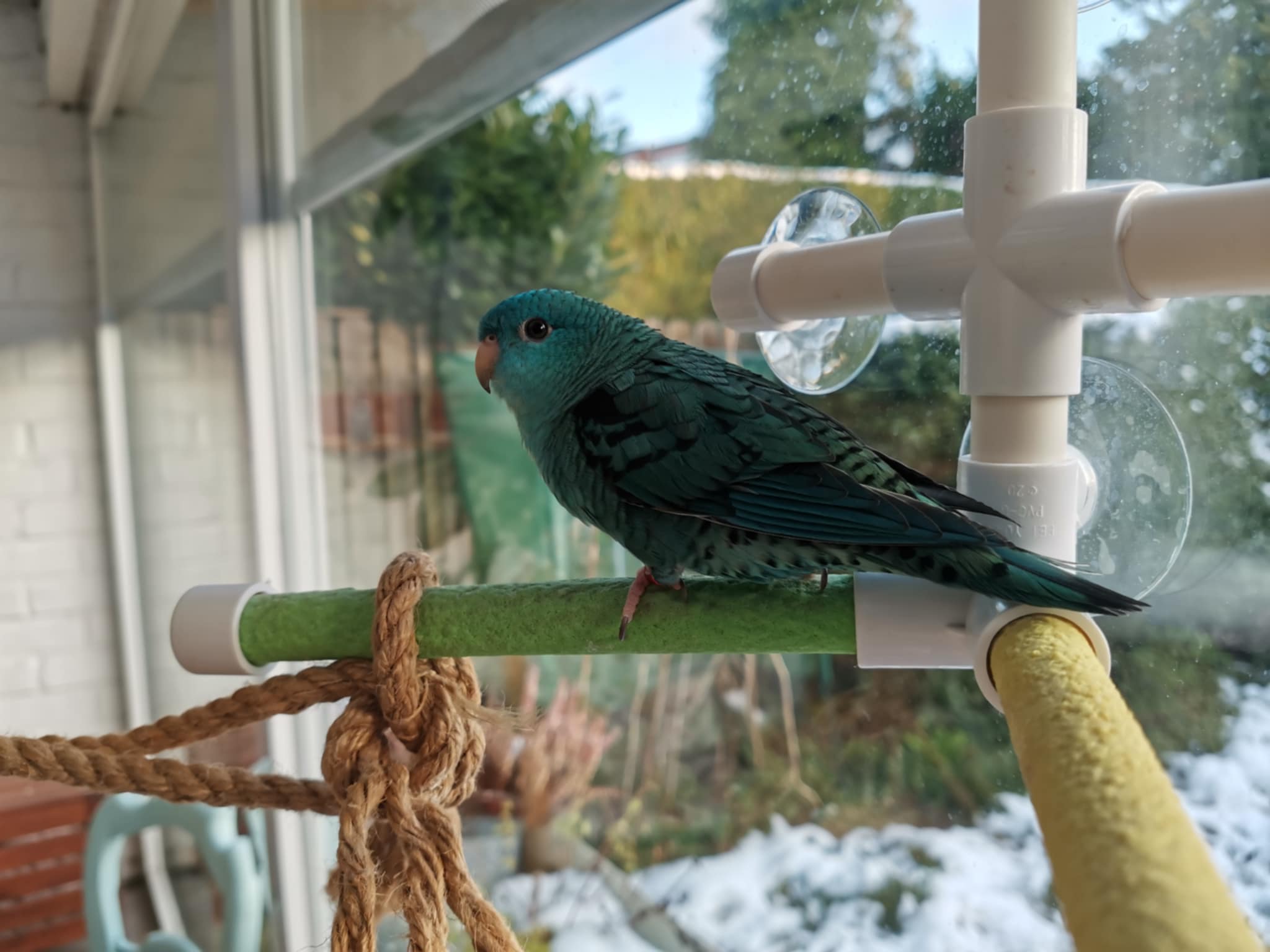How to Care for Lineolated Parakeets – 12 Essential Tips
The lineolated parakeet, often called the “barred parakeet” represents one of the most charming and underappreciated companion birds in the avian world. These delightful creatures captivate bird enthusiasts with their gentle demeanor and distinctive striped plumage that sets them apart from their more common parakeet cousins.
Table of Contents

Understanding the Lineolated Parakeet: An Introduction to These Remarkable Birds
This parakeet (Bolborhynchus lineola) originates from the mountainous regions of Central and South America, where they inhabit cloud forests and high-altitude environments. Unlike the typical image of vibrant tropical parrots, these birds have evolved to thrive in cooler, more temperate conditions, making them uniquely suited for home environments.
What makes the lineolated parakeet particularly appealing to novice bird owners is their remarkably calm disposition. These birds rarely exhibit the aggressive tendencies or excessive vocalizations that can overwhelm first-time bird parents. Their soft, melodious chirping creates a pleasant ambient soundtrack rather than disruptive noise.
Physical Characteristics That Define the Lineolated Parakeet
The most distinctive feature of any lineolated parakeet is the intricate barring pattern that adorns their feathers, creating horizontal stripes across their wings and back. Adults typically measure 6-7 inches in length, making them larger than budgerigars but smaller than cockatiels. Their robust build and sturdy constitution contribute to their reputation as hardy companion birds.
Color variations in captive lineolated parakeet populations include the traditional green with black barring, lutino (yellow with reduced markings), blue mutations, and various combinations that create stunning visual appeal. Each bird’s unique pattern makes them as individual as fingerprints.
1. Housing Requirements: Creating the Perfect Environment for Your Lineolated Parakeet
Selecting the Appropriate Cage Size and Configuration
The foundation of proper lineolated parakeet care begins with providing adequate housing space. While these birds are smaller than many parrot species, they require surprising amounts of room to exercise and explore. The minimum cage dimensions should measure 32 inches wide, 18 inches deep, and 24 inches high for a single bird.
Horizontal space proves more crucial than vertical height for lineolated parakeet wellbeing, as these birds prefer moving side-to-side rather than climbing extensively. Bar spacing should measure between 1/2 and 5/8 inches to prevent escape while allowing comfortable perching.
Essential Cage Accessories and Perching Solutions
Natural wood perches of varying diameters promote healthy foot exercise and prevent the development of pressure sores. Include perches ranging from 1/2 inch to 1 inch in diameter, positioning them at different heights to encourage movement throughout the cage space.
Avoid sandpaper-covered perches, which can cause abrasions and discomfort to your lineolated parakeet’s delicate feet. Instead, opt for natural branches from safe wood species like apple, birch, or willow that provide texture variation and enrichment opportunities.
2. Nutritional Excellence: Feeding Your Lineolated Parakeet for Optimal Health
Foundation Diet: High-Quality Pellets and Seed Combinations
The cornerstone of lineolated parakeet nutrition should consist of premium commercial pellets specifically formulated for small hookbills. These pellets should comprise 70-80% of their daily food intake, providing balanced nutrition without the selective eating problems associated with all-seed diets.
Supplement the pellet foundation with a limited quantity of high-quality seed mix, focusing on varieties like millet, canary seed, and small amounts of sunflower seeds. The total daily food quantity for an adult lineolated parakeet should measure approximately 1-2 tablespoons, adjusted based on individual bird size and activity level.
Fresh Foods and Dietary Enrichment Opportunities
Fresh vegetables should constitute 15-20% of your lineolated parakeet’s daily nutrition. Excellent choices include dark leafy greens like kale and spinach, orange vegetables such as carrots and sweet potatoes, and cruciferous vegetables including broccoli and cauliflower.
Fruits can be offered 2-3 times weekly in small quantities, with safe options including apples (seeds removed), berries, and melons. Always research any new food items before offering them, as some common human foods prove toxic to birds.
3. Social Dynamics: Understanding Lineolated Parakeet Behavior and Interaction Needs
Companionship Considerations for Single vs. Multiple Birds
Lineolated parakeet social needs differ significantly from more gregarious parrot species. While they appreciate companionship, many individuals thrive as single birds with adequate human interaction. However, pairs or small groups can coexist harmoniously when introduced properly and provided sufficient space.
Single lineolated parakeet ownership allows for stronger human-bird bonding, as the bird will typically view their human caretaker as their primary social companion. This arrangement often results in more interactive and engaging pet relationships.
Communication Patterns and Vocalization Understanding
The lineolated parakeet communicates through soft chirping, gentle trilling, and subtle body language cues. Unlike louder parrot species, these birds rarely engage in prolonged screaming sessions or demanding vocalizations that can disturb household harmony.
Learning to interpret your bird’s communication signals enhances the human-animal bond and helps identify potential health or behavioral concerns before they escalate into serious problems.
4. Health Maintenance: Preventive Care for Your Lineolated Parakeet

Recognizing Signs of Illness and When to Seek Veterinary Care
Lineolated parakeet health monitoring requires daily observation of behavior patterns, eating habits, and physical appearance. Healthy birds maintain bright, alert expressions, smooth feather condition, and consistent activity levels throughout their waking hours.
Warning signs that warrant immediate veterinary attention include fluffed feathers maintained for extended periods, changes in droppings consistency or color, labored breathing, or significant behavioral changes like increased sleeping or reduced appetite.
Establishing Routine Health Practices
Regular weighing provides valuable health monitoring data, as weight fluctuations often indicate health problems before other symptoms become apparent. A healthy adult lineolated parakeet typically weighs between 52-62 grams, with individual variations based on size and body structure.
Maintaining detailed health records helps identify patterns and provides valuable information for veterinary consultations. Document daily food consumption, weight measurements, behavioral observations, and any concerns or changes in routine.
5. Environmental Enrichment: Stimulating Your Lineolated Parakeet’s Mind and Body
Toy Selection and Rotation Strategies
Mental stimulation proves crucial for lineolated parakeet psychological wellbeing. These intelligent birds require variety and challenge to prevent boredom-related behavioral problems. Rotate toys weekly to maintain novelty and interest, focusing on different types of enrichment activities.
Foraging opportunities simulate natural behaviors and provide excellent mental exercise. Hide food items in paper cups, wrap treats in paper, or use commercial foraging toys designed for small birds to encourage natural searching behaviors.
Creating Safe Out-of-Cage Time Experiences
Supervised out-of-cage time allows your lineolated parakeet to exercise flight muscles and explore beyond their immediate living space. Ensure all windows and doors are secured, remove potential hazards like ceiling fans or toxic plants, and establish designated safe areas for exploration.
Flight exercise contributes significantly to physical fitness and psychological wellbeing. Even clipped birds benefit from supervised exploration time outside their cage environment.
6. Temperature and Climate Control for Lineolated Parakeet Comfort
Optimal Temperature Ranges and Environmental Conditions
Lineolated parakeet temperature preferences reflect their high-altitude origins, with comfort ranges between 65-75°F (18-24°C). These birds tolerate cooler temperatures better than many tropical species but remain sensitive to extreme temperature fluctuations and drafts.
Maintain consistent humidity levels between 50-60% to support respiratory health and feather condition. Use a hygrometer to monitor humidity levels and consider using a humidifier during dry winter months.
7. Grooming and Maintenance: Keeping Your Lineolated Parakeet Healthy
Wing Clipping Considerations
Wing clipping remains a personal choice for lineolated parakeet owners. These birds are strong fliers and benefit from flight exercise, but clipping may be necessary for safety in homes with many hazards. Consult with an avian veterinarian to determine the best approach for your specific situation.
If you choose to clip wings, have it done professionally to ensure proper technique and avoid injury. Partial clips that allow controlled gliding often work better than severe clips that eliminate all flight capability.
Nail and Beak Maintenance
Regular nail trimming prevents overgrowth that can lead to injury or difficulty perching. Most lineolated parakeets require nail trims every 6-8 weeks, depending on their activity level and perch materials.
Healthy lineolated parakeets typically maintain their beaks naturally through normal eating and chewing activities. Provide appropriate chew toys and cuttlebone to support natural beak conditioning.
8. Establishing Daily Routines and Schedules
Creating Consistent Sleep Patterns
Lineolated parakeets require 10-12 hours of uninterrupted sleep each night to maintain optimal health. Establish a consistent bedtime routine by covering the cage or moving your bird to a quiet, dark room.
Maintain regular wake-up times to establish circadian rhythms that support healthy hormone production and behavioral patterns. Consistency in daily schedules helps reduce stress and promotes overall wellbeing.
Feeding Schedules and Meal Planning
Provide fresh food and water daily, removing uneaten fresh foods after 2-4 hours to prevent spoilage. Many lineolated parakeet owners find success with twice-daily feeding schedules, offering fresh foods in the morning and evening.
Monitor food consumption patterns to identify any changes that might indicate health concerns. Sudden increases or decreases in appetite often signal the need for veterinary evaluation.
9. Training and Behavioral Development
Basic Training Techniques for Lineolated Parakeets
Lineolated parakeets respond well to positive reinforcement training methods. Start with simple commands like “step up” and “step down” using favorite treats as rewards. These birds are intelligent and can learn various tricks and behaviors with patience and consistency.
Target training helps establish communication and trust between you and your bird. Use a chopstick or similar object as a target, rewarding your parakeet when they touch it with their beak.
Addressing Common Behavioral Issues
Feather plucking, excessive screaming, or aggression are relatively rare in lineolated parakeets but can occur due to stress, boredom, or health issues. Address behavioral problems by first ruling out medical causes, then examining environmental factors and enrichment opportunities.
Consistent training and positive reinforcement help prevent most behavioral issues before they develop into serious problems.

10. Breeding Considerations for Advanced Owners
Understanding Lineolated Parakeet Reproduction
Lineolated parakeets typically reach sexual maturity around 10-12 months of age. Breeding pairs require additional space, specialized nest boxes, and enhanced nutrition to support reproductive health.
Egg-laying can occur even in single birds, particularly during spring months when hormonal changes are most pronounced. Provide adequate calcium sources and monitor for signs of egg-binding, which requires immediate veterinary attention.
Responsible Breeding Practices
Only experienced bird owners should consider breeding lineolated parakeets. Ensure you have homes lined up for offspring, adequate space for multiple birds, and emergency veterinary care available during breeding season.
Genetic diversity is important in breeding programs to prevent inbreeding and maintain healthy populations. Research bloodlines and work with reputable breeders to ensure genetic health.
11. Emergency Preparedness and First Aid
Building a Basic Avian First Aid Kit
Every lineolated parakeet owner should maintain a basic first aid kit containing sterile gauze, styptic powder for bleeding nails, a small towel for restraint, and contact information for emergency veterinary services.
Learn basic restraint techniques to safely handle your bird during emergencies. Practice these techniques regularly when your bird is healthy to reduce stress during actual emergencies.
Recognizing Emergency Situations
True emergencies requiring immediate veterinary attention include severe bleeding, difficulty breathing, seizures, or any sudden collapse or loss of consciousness. Have your avian veterinarian’s contact information readily available, including after-hours emergency services.
Poisoning from toxic substances, severe injuries from accidents, or signs of severe illness like vomiting or extreme lethargy also constitute emergencies requiring immediate professional care.
12. Long-term Care Planning and Considerations
Lifespan and Aging Considerations
Lineolated parakeets can live 15-20 years with proper care, making them a long-term commitment. Plan for changes in your bird’s needs as they age, including potential health issues and modified care requirements.
Senior lineolated parakeets may require softer foods, additional warmth, and more frequent veterinary checkups to maintain optimal health and quality of life.
Travel and Vacation Planning
Establish relationships with qualified pet sitters or boarding facilities experienced with birds before you need them. Provide detailed care instructions including feeding schedules, emergency contacts, and behavioral information.
Consider your bird’s needs when planning extended trips. Some lineolated adapt well to travel, while others prefer staying in familiar environments with trusted caretakers.
Conclusion
Lineolated parakeets offer a perfect blend of beauty, intelligence, and manageable care requirements that make them ideal companions for both novice and experienced bird owners. Their gentle nature, distinctive appearance, and adaptable personalities create rewarding relationships that can last for decades.
Success with lineolated parakeets comes from understanding their unique needs, providing consistent care, and appreciating their subtle charms. These remarkable birds may not be the loudest or most colorful in the avian world, but they compensate with their endearing personalities and genuine affection for their human companions.
By following these 12 comprehensive care tips, you’ll be well-equipped to provide your lineolated parakeet with a healthy, enriching life that brings joy to both you and your feathered friend for many years to come.
FAQ
Are lineolated parakeets good pets for beginners?
Yes, lineolated parakeets are excellent pets for beginners. Their calm, gentle nature makes them much easier to handle than many other parrot species. They’re less likely to bite, rarely scream loudly, and adapt well to human companionship.
How much do lineolated parakeets cost to buy and maintain?
Lineolated parakeets typically cost between $200-$400 to purchase, depending on color mutations and breeder reputation. Initial setup costs including cage, perches, toys, and food dishes can range from $300-$600. Monthly maintenance costs average $30-$50 for food, toys, and supplies. Annual veterinary checkups cost $75-$150, with emergency visits potentially costing several hundred dollars. Budget at least $1,000 for the first year of ownership.
Can lineolated parakeets learn to talk?
While lineolated parakeets are capable of learning some words and phrases, they’re not known as prolific talkers like cockatiels or larger parrots. Some individuals may learn to mimic household sounds, whistle simple tunes, or say a few words, but many remain relatively quiet. Their charm lies more in their gentle personality and beautiful appearance rather than their vocal abilities. Don’t choose a lineolated parakeet expecting extensive talking capabilities.
Do lineolated parakeets need to be kept in pairs?
Lineolated parakeets can thrive either as single birds or in pairs, depending on the amount of human interaction they receive. Single birds often form stronger bonds with their human caretakers and can be more interactive pets. Pairs provide companionship for each other but may be less interested in human interaction. If you can’t provide several hours of daily interaction, a pair might be better. However, pairs require larger cages and may be more likely to breed, which brings additional responsibilities.
Did you enjoy this article?
Help other pet lovers benefit too — Share it on social media! 🐾💚


Leave a Reply